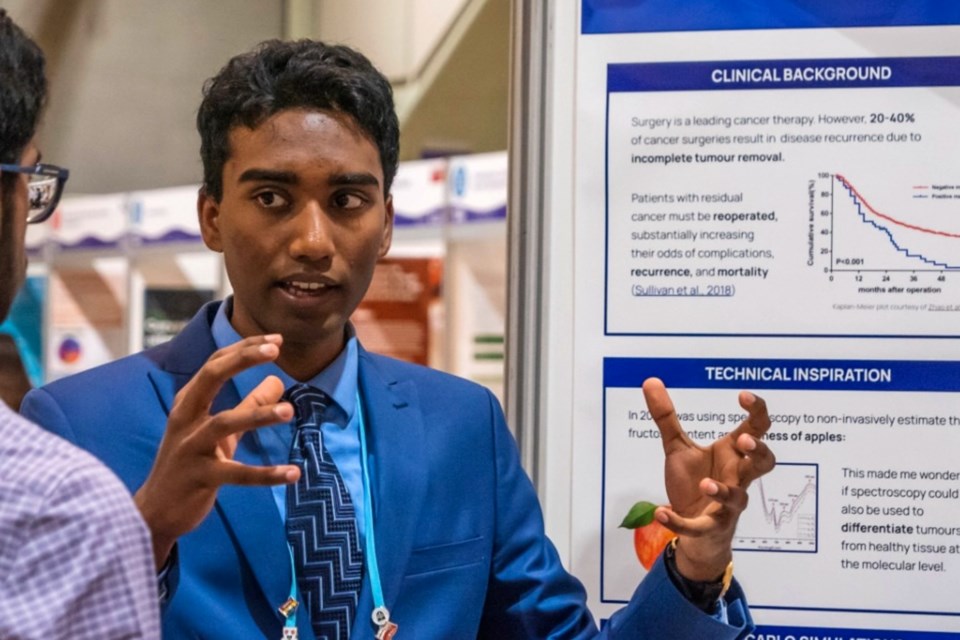Where the rest of us see problems, Aaryan Harshith sees solutions.
A Grade 12 student at Lo-Ellen Park Secondary School, Harshith recently won silver at the Canada Wide Science Fair after sweeping the Sudbury Regional Science Fair. But that's the least of what he's accomplished.
Harshith has developed a technology that uses light to distinguish between cancerous and healthy tissue, potentially allowing patients to be cured in their first operation.
“Surgery is one of the leading treatments for cancer, but a significant portion of these procedures fail because surgeons leave behind microscopic traces of cancer cells in patients, which can reproliferate into new tumours that must be reoperated,” Aaryan said. “Today, we determine the presence of leftover cancer cells in patients through facilities known as pathology labs, which analyze samples of patient tissue under microscopes. Unfortunately, these tests can take weeks to complete, meaning that patients with residual cancer have to be reoperated.”
The technology Harshith has created is called LightIR.
“To support their abnormal growth, tumours manufacture a variety of molecules at characteristically different levels from normal tissue,” Aaryan said. “Since different molecules respond to and interact with light differently, it follows that cancerous and healthy tissue will have unique optical properties. These are exactly the differences that LightIR exploits.”
When asked about the inspiration for his ingenious invention, Harshith said the idea was born from research he'd been doing at the time, coupled with an interest in the common killer, cancer.
“I've always loved building things, and the process of taking very abstract ideas in my head and making them real,” he said. “At the same time, I'm really captivated by the biology of cancer. Back in 2019, I stumbled on a paper highlighting the scale of cancer surgery, and just how many of these procedures were unsuccessful because of this painfully simple bottleneck.
“Around this time, I was also experimenting with a technique called vis-NIR spectroscopy, which allows scientists to understand the chemical content of unknown substances just by irradiating them with light. Being interested in both these areas simultaneously was really the impetus for this project.”
While the science drives Harshith to create, he said he just wants to give back to the world.
“I see my inventions and projects as contributions to the world around me. Coming up with something new and sharing it with the world is inherently valuable. That's what makes science so powerful, and I'm proud to say I've added to science in my own little way.”
Harshith said having parents who work within the medical community has also been inspirational.
“Both my parents are physiotherapists. And when both your parents work in the health-care profession, conversations at the dinner table usually come back to anecdotes from the hospital, or gaps in the health-care system. Naturally, growing up in that atmosphere tunes you to think about medicine and biotech every once in a while.”
He also credits the country where he is being educated for the chance to make the contributions he's making.
“Perhaps more interestingly, I was born in India, where quality education and opportunities are far harder to come by than they are in Canada. As a first-generation immigrant, I think the biggest gift my parents gave me was this country, where there is no ceiling to what I can do. That really made all the difference.”
When asked if there's a message he'd like to get out there, Harshith is direct. “If you're reading this right now and you're in high-school, I think the best advice I would give to my ninth-grade self would be to believe in yourself, and do hard things on purpose. The worst case scenario is that nothing happens. The best case scenario is probably beyond your imagination. Whatever you care about, go for it, and go for it at full force.”
Harshith will be studying engineering at university starting this Fall. He views his future through a lens of realism. “I find joy in the process of building things. Aside from LightIR, there are dozens of ideas floating around in my head (mostly in relation to health) that I'd like to at least tinker with. Beyond that, maybe I'll spend my time as a serial inventor, constantly coming up with new inventions and selling them to companies that have the time and resources to bring them to the market. That way, I can keep doing what I'm good at, and my ideas can reach the people that need them the most.”
Aaryan Harshith's words of inspiration
“Whatever you care about, go for it, and go for it at full force.”
James Stewart is a writer in North Bay. Inspire is made possible by our Community Leaders Program.
